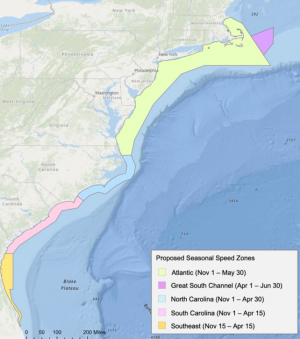
OCEAN CITY – While a long-term decision on a proposed rule change to reduce offshore speed limits for recreational and commercial vessels to further protect endangered North Atlantic right whales hangs in the balance, a national environmental advocacy group this week filed an emergency rulemaking petition urging the federal government to institute the change immediately.
In an effort to save endangered North American right whales, the National Oceanic and Atmospheric Administration (NOAA) has proposed a 10-knot speed restriction for recreational and commercial vessels 35 feet in length or greater, down from the current 65 feet. The proposed rule change would expand the go-slow zones to include virtually the entire east coast out to a 90-mile radius and extend the zone restrictions as long as seven months out of the year.
NOAA’s public comment period on the proposed rule change expired last month and no final order has yet been handed down. However, the national environmental advocacy group Oceana this week filed an emergency rulemaking petition seeking an immediate implementation of the proposed 10-knot rule.
Oceana filed the emergency petition this week because no final rule change has yet been established and the North American right whale calving season as begun up and down the east coast. Oceana’s petition was sent to Secretary of Commerce Gina Raimondo and National Marine Fisheries Service (NMFS) Assistant Administrator Janet Coit demanding immediate action on the proposed 10-knot rule change.
“We are sounding the alarm for our government to step in and establish immediate protections for North Atlantic right whales during the calving season,” said Oceana Campaign Director Gib Brogan. “As the nation’s stewards of our oceans, it is Secretary Raimondo’s responsibility to take action to protect these critically endangered whales. These whales are faced with a number of life-threatening perils along their journey. Boat collisions and entanglement in fishing gear remain the top two causes of death for the species. While broader and permanent safeguards are desperately needed, the government must take immediate action now to protect these mothers and their newly-born calves today.”
The emergency petition filed by Oceana calls for the federal government to bypass the rule-change process and take immediate action to implement the 10-knot rule up and down the east coast, including off the coast of Ocean City. It’s important to note the proposed 10-knot rule change, if implemented by NOAA, would be in effect off the mid-Atlantic coast until May 31.
“Every North Atlantic right whale birth offers a chance for recovery of this critically endangered species,” Brogan said. “With birth rates low and continued deaths from human causes, the window for being able to turn the tide for these whales is frighteningly narrow. Our government has the necessary tools to give them a fighting chance for survival and it should implement them immediately.”
While no one is arguing with attempts to save the critically endangered North American right whales, the proposed rule change could severely damage the local fishing industry. While the proposed rule change would only be in effect from Nov. to May 31, which is just on the shoulders of the recreational fishing season locally, the 10-knot rule could be applied at any time by NOAA if a right whale is spotted in the fishing grounds off the coast.
The local fishing community, along with fishing advocacy groups up and down the east coast, from the beginning have railed against the proposed 10-knot rule change. While all agree protecting the endangered species is important, there is limited data suggesting vessel strikes are contributing to mortality rates.
According to NOAA, the latest estimate puts the entire North American right whale population at around 350, including fewer than 100 breeding females. The right whales migrate up and down the east coast and in and out of the fishing grounds and shipping lanes at different times during the year to their known calving grounds in more shallow and warmer climates.
However, fishing advocates have said the data doesn’t suggest vessel strikes are the primary cause of the whale’s mortality rates. For example, according NOAA’s own data, there have only been 12 lethal right whale vessel strikes since 2008, five of which have come from vessel’s under 35 feet. From NOAA’s own data, the chance of a vessel striking a right whale, considering the sheer volume of boat traffic in the prescribed zones for the rule change, is about on in a million.
Locally, virtually all of the fishing grounds frequented by recreational and commercial fishermen would fall under the 10-knot rule. Operating a vessel at a maximum of 10 knots would add several hours to a typical charter or private fishing trip, trips that already often take much of the day.
Charters that target billfish, tuna and mahi, for example, often travel nearly 100 miles to reach the canyons offshore and leave well before sunrise and return in the evening. It’s often a three-hour-plus ride to reach the offshore canyons without any 10-knot maximum speed in place. To put it in perspective, one knot is equal to around 1.15 miles per hour. So, 10 knots would be a little over 11 miles per hour.

